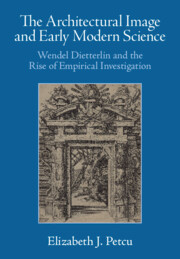 The Architectural Image and Early Modern Science
The Architectural Image and Early Modern Science Published online by Cambridge University Press: 29 November 2024
The fifteenth- and sixteenth-century revival of Vitruvius’s theory of architecture as art and science as well as the Reformation and the rise of print spurred a “figural turn” in architectural culture and the advent of a new genre of architectural images. In northern Europe, four institutions – artist guilds, publishers, masons’ lodges, and courts – acted as the key contexts for the figural turn. Artists began to specialize in forming architectural images, thereby making inroads into architectural professions and enriching the conventional practices of architectural design with new artistic and scientific modes of visual research. Matthias Grünewald’s Isenheim Altarpiece, façade paintings by Wendel Dietterlin and Hans Holbein the Younger, and printer Bernhard Jobin’s collaborations with builder Daniel Specklin to form scientifically informed architectural prints all exemplify the figural turn. So, too, did Dietterlin’s botanically rich mural for the Strasbourg Masons and Stonecutters, as well as an empirically conceived, microcosmic interior Dietterlin made for the Duke of Württemberg. By the middle of the sixteenth century, artists and natural philosophers had introduced empirical visual research methods to northern Europe’s developing culture of architectural images, setting the stage for Dietterlin’s seminal Architectura.
To save this book to your Kindle, first ensure [email protected] is added to your Approved Personal Document E-mail List under your Personal Document Settings on the Manage Your Content and Devices page of your Amazon account. Then enter the ‘name’ part of your Kindle email address below. Find out more about saving to your Kindle.
Note you can select to save to either the @free.kindle.com or @kindle.com variations. ‘@free.kindle.com’ emails are free but can only be saved to your device when it is connected to wi-fi. ‘@kindle.com’ emails can be delivered even when you are not connected to wi-fi, but note that service fees apply.
Find out more about the Kindle Personal Document Service.
To save content items to your account, please confirm that you agree to abide by our usage policies. If this is the first time you use this feature, you will be asked to authorise Cambridge Core to connect with your account. Find out more about saving content to Dropbox.
To save content items to your account, please confirm that you agree to abide by our usage policies. If this is the first time you use this feature, you will be asked to authorise Cambridge Core to connect with your account. Find out more about saving content to Google Drive.